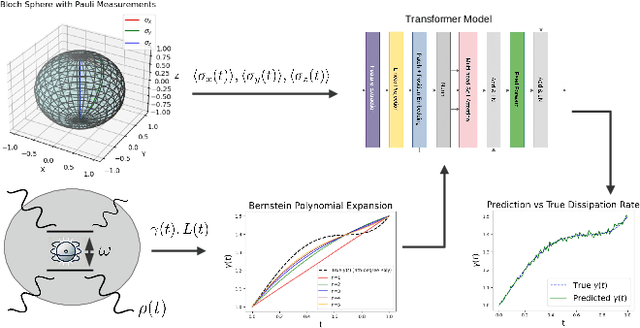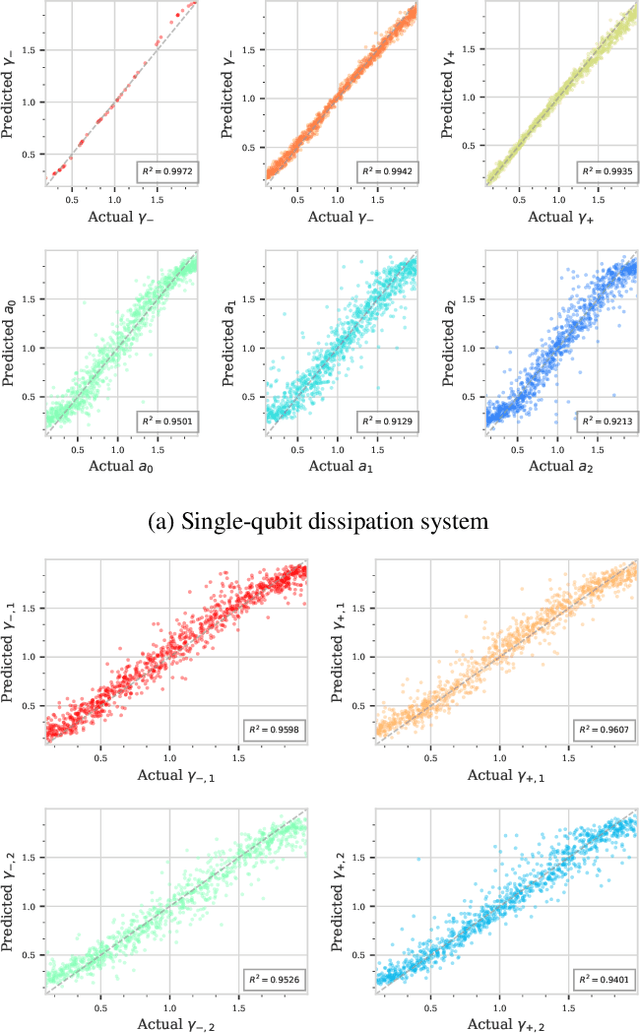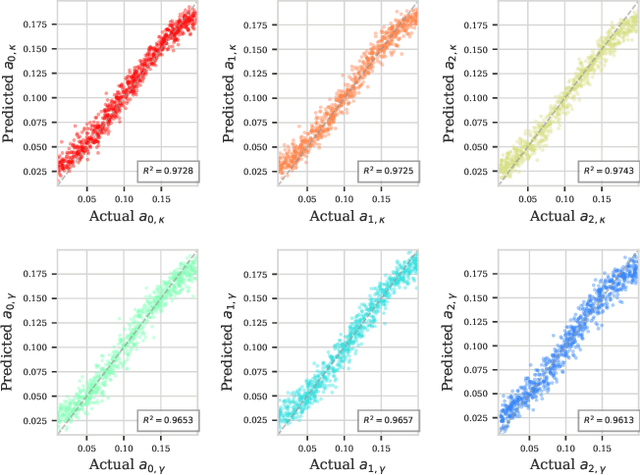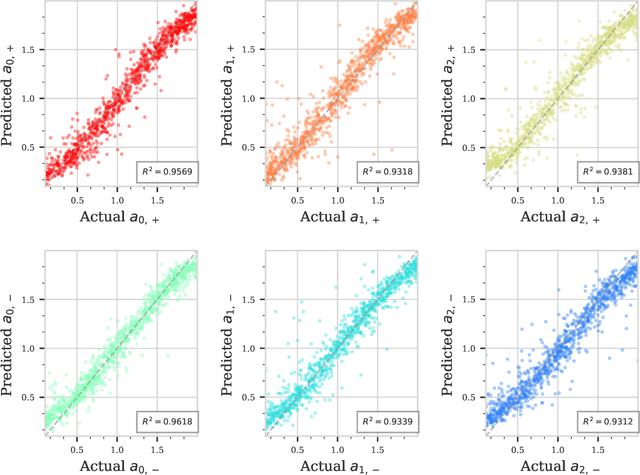Chi-Sheng Chen
Quantum Reinforcement Learning-Guided Diffusion Model for Image Synthesis via Hybrid Quantum-Classical Generative Model Architectures
Sep 17, 2025Abstract:Diffusion models typically employ static or heuristic classifier-free guidance (CFG) schedules, which often fail to adapt across timesteps and noise conditions. In this work, we introduce a quantum reinforcement learning (QRL) controller that dynamically adjusts CFG at each denoising step. The controller adopts a hybrid quantum--classical actor--critic architecture: a shallow variational quantum circuit (VQC) with ring entanglement generates policy features, which are mapped by a compact multilayer perceptron (MLP) into Gaussian actions over $\Delta$CFG, while a classical critic estimates value functions. The policy is optimized using Proximal Policy Optimization (PPO) with Generalized Advantage Estimation (GAE), guided by a reward that balances classification confidence, perceptual improvement, and action regularization. Experiments on CIFAR-10 demonstrate that our QRL policy improves perceptual quality (LPIPS, PSNR, SSIM) while reducing parameter count compared to classical RL actors and fixed schedules. Ablation studies on qubit number and circuit depth reveal trade-offs between accuracy and efficiency, and extended evaluations confirm robust generation under long diffusion schedules.
Q-DPTS: Quantum Differentially Private Time Series Forecasting via Variational Quantum Circuits
Aug 07, 2025Abstract:Time series forecasting is vital in domains where data sensitivity is paramount, such as finance and energy systems. While Differential Privacy (DP) provides theoretical guarantees to protect individual data contributions, its integration especially via DP-SGD often impairs model performance due to injected noise. In this paper, we propose Q-DPTS, a hybrid quantum-classical framework for Quantum Differentially Private Time Series Forecasting. Q-DPTS combines Variational Quantum Circuits (VQCs) with per-sample gradient clipping and Gaussian noise injection, ensuring rigorous $(\epsilon, \delta)$-differential privacy. The expressiveness of quantum models enables improved robustness against the utility loss induced by DP mechanisms. We evaluate Q-DPTS on the ETT (Electricity Transformer Temperature) dataset, a standard benchmark for long-term time series forecasting. Our approach is compared against both classical and quantum baselines, including LSTM, QASA, QRWKV, and QLSTM. Results demonstrate that Q-DPTS consistently achieves lower prediction error under the same privacy budget, indicating a favorable privacy-utility trade-off. This work presents one of the first explorations into quantum-enhanced differentially private forecasting, offering promising directions for secure and accurate time series modeling in privacy-critical scenarios.
Benchmarking Quantum and Classical Sequential Models for Urban Telecommunication Forecasting
Aug 06, 2025Abstract:In this study, we evaluate the performance of classical and quantum-inspired sequential models in forecasting univariate time series of incoming SMS activity (SMS-in) using the Milan Telecommunication Activity Dataset. Due to data completeness limitations, we focus exclusively on the SMS-in signal for each spatial grid cell. We compare five models, LSTM (baseline), Quantum LSTM (QLSTM), Quantum Adaptive Self-Attention (QASA), Quantum Receptance Weighted Key-Value (QRWKV), and Quantum Fast Weight Programmers (QFWP), under varying input sequence lengths (4, 8, 12, 16, 32 and 64). All models are trained to predict the next 10-minute SMS-in value based solely on historical values within a given sequence window. Our findings indicate that different models exhibit varying sensitivities to sequence length, suggesting that quantum enhancements are not universally advantageous. Rather, the effectiveness of quantum modules is highly dependent on the specific task and architectural design, reflecting inherent trade-offs among model size, parameterization strategies, and temporal modeling capabilities.
Quantum Reinforcement Learning Trading Agent for Sector Rotation in the Taiwan Stock Market
Jun 26, 2025Abstract:We propose a hybrid quantum-classical reinforcement learning framework for sector rotation in the Taiwan stock market. Our system employs Proximal Policy Optimization (PPO) as the backbone algorithm and integrates both classical architectures (LSTM, Transformer) and quantum-enhanced models (QNN, QRWKV, QASA) as policy and value networks. An automated feature engineering pipeline extracts financial indicators from capital share data to ensure consistent model input across all configurations. Empirical backtesting reveals a key finding: although quantum-enhanced models consistently achieve higher training rewards, they underperform classical models in real-world investment metrics such as cumulative return and Sharpe ratio. This discrepancy highlights a core challenge in applying reinforcement learning to financial domains -- namely, the mismatch between proxy reward signals and true investment objectives. Our analysis suggests that current reward designs may incentivize overfitting to short-term volatility rather than optimizing risk-adjusted returns. This issue is compounded by the inherent expressiveness and optimization instability of quantum circuits under Noisy Intermediate-Scale Quantum (NISQ) constraints. We discuss the implications of this reward-performance gap and propose directions for future improvement, including reward shaping, model regularization, and validation-based early stopping. Our work offers a reproducible benchmark and critical insights into the practical challenges of deploying quantum reinforcement learning in real-world finance.
Vision-QRWKV: Exploring Quantum-Enhanced RWKV Models for Image Classification
Jun 07, 2025Abstract:Recent advancements in quantum machine learning have shown promise in enhancing classical neural network architectures, particularly in domains involving complex, high-dimensional data. Building upon prior work in temporal sequence modeling, this paper introduces Vision-QRWKV, a hybrid quantum-classical extension of the Receptance Weighted Key Value (RWKV) architecture, applied for the first time to image classification tasks. By integrating a variational quantum circuit (VQC) into the channel mixing component of RWKV, our model aims to improve nonlinear feature transformation and enhance the expressive capacity of visual representations. We evaluate both classical and quantum RWKV models on a diverse collection of 14 medical and standard image classification benchmarks, including MedMNIST datasets, MNIST, and FashionMNIST. Our results demonstrate that the quantum-enhanced model outperforms its classical counterpart on a majority of datasets, particularly those with subtle or noisy class distinctions (e.g., ChestMNIST, RetinaMNIST, BloodMNIST). This study represents the first systematic application of quantum-enhanced RWKV in the visual domain, offering insights into the architectural trade-offs and future potential of quantum models for lightweight and efficient vision tasks.
Unraveling Quantum Environments: Transformer-Assisted Learning in Lindblad Dynamics
May 11, 2025



Abstract:Understanding dissipation in open quantum systems is crucial for the development of robust quantum technologies. In this work, we introduce a Transformer-based machine learning framework to infer time-dependent dissipation rates in quantum systems governed by the Lindblad master equation. Our approach uses time series of observable quantities, such as expectation values of single Pauli operators, as input to learn dissipation profiles without requiring knowledge of the initial quantum state or even the system Hamiltonian. We demonstrate the effectiveness of our approach on a hierarchy of open quantum models of increasing complexity, including single-qubit systems with time-independent or time-dependent jump rates, two-qubit interacting systems (e.g., Heisenberg and transverse Ising models), and the Jaynes--Cummings model involving light--matter interaction and cavity loss with time-dependent decay rates. Our method accurately reconstructs both fixed and time-dependent decay rates from observable time series. To support this, we prove that under reasonable assumptions, the jump rates in all these models are uniquely determined by a finite set of observables, such as qubit and photon measurements. In practice, we combine Transformer-based architectures with lightweight feature extraction techniques to efficiently learn these dynamics. Our results suggest that modern machine learning tools can serve as scalable and data-driven alternatives for identifying unknown environments in open quantum systems.
Quantum Adaptive Self-Attention for Quantum Transformer Models
Apr 05, 2025Abstract:Transformer models have revolutionized sequential learning across various domains, yet their self-attention mechanism incurs quadratic computational cost, posing limitations for real-time and resource-constrained tasks. To address this, we propose Quantum Adaptive Self-Attention (QASA), a novel hybrid architecture that enhances classical Transformer models with a quantum attention mechanism. QASA replaces dot-product attention with a parameterized quantum circuit (PQC) that adaptively captures inter-token relationships in the quantum Hilbert space. Additionally, a residual quantum projection module is introduced before the feedforward network to further refine temporal features. Our design retains classical efficiency in earlier layers while injecting quantum expressiveness in the final encoder block, ensuring compatibility with current NISQ hardware. Experiments on synthetic time-series tasks demonstrate that QASA achieves faster convergence and superior generalization compared to both standard Transformers and reduced classical variants. Preliminary complexity analysis suggests potential quantum advantages in gradient computation, opening new avenues for efficient quantum deep learning models.
Psycho Gundam: Electroencephalography based real-time robotic control system with deep learning
Nov 16, 2024Abstract:The Psycho Frame, a sophisticated system primarily used in Universal Century (U.C.) series mobile suits for NEWTYPE pilots, has evolved as an integral component in harnessing the latent potential of mental energy. Its ability to amplify and resonate with the pilot's psyche enables real-time mental control, creating unique applications such as psychomagnetic fields and sensory-based weaponry. This paper presents the development of a novel robotic control system inspired by the Psycho Frame, combining electroencephalography (EEG) and deep learning for real-time control of robotic systems. By capturing and interpreting brainwave data through EEG, the system extends human cognitive commands to robotic actions, reflecting the seamless synchronization of thought and machine, much like the Psyco Frame's integration with a Newtype pilot's mental faculties. This research demonstrates how modern AI techniques can expand the limits of human-machine interaction, potentially transcending traditional input methods and enabling a deeper, more intuitive control of complex robotic systems.
NECOMIMI: Neural-Cognitive Multimodal EEG-informed Image Generation with Diffusion Models
Oct 01, 2024



Abstract:NECOMIMI (NEural-COgnitive MultImodal EEG-Informed Image Generation with Diffusion Models) introduces a novel framework for generating images directly from EEG signals using advanced diffusion models. Unlike previous works that focused solely on EEG-image classification through contrastive learning, NECOMIMI extends this task to image generation. The proposed NERV EEG encoder demonstrates state-of-the-art (SoTA) performance across multiple zero-shot classification tasks, including 2-way, 4-way, and 200-way, and achieves top results in our newly proposed Category-based Assessment Table (CAT) Score, which evaluates the quality of EEG-generated images based on semantic concepts. A key discovery of this work is that the model tends to generate abstract or generalized images, such as landscapes, rather than specific objects, highlighting the inherent challenges of translating noisy and low-resolution EEG data into detailed visual outputs. Additionally, we introduce the CAT Score as a new metric tailored for EEG-to-image evaluation and establish a benchmark on the ThingsEEG dataset. This study underscores the potential of EEG-to-image generation while revealing the complexities and challenges that remain in bridging neural activity with visual representation.
Res-VMamba: Fine-Grained Food Category Visual Classification Using Selective State Space Models with Deep Residual Learning
Feb 24, 2024Abstract:Food classification is the foundation for developing food vision tasks and plays a key role in the burgeoning field of computational nutrition. Due to the complexity of food requiring fine-grained classification, recent academic research mainly modifies Convolutional Neural Networks (CNNs) and/or Vision Transformers (ViTs) to perform food category classification. However, to learn fine-grained features, the CNN backbone needs additional structural design, whereas ViT, containing the self-attention module, has increased computational complexity. In recent months, a new Sequence State Space (S4) model, through a Selection mechanism and computation with a Scan (S6), colloquially termed Mamba, has demonstrated superior performance and computation efficiency compared to the Transformer architecture. The VMamba model, which incorporates the Mamba mechanism into image tasks (such as classification), currently establishes the state-of-the-art (SOTA) on the ImageNet dataset. In this research, we introduce an academically underestimated food dataset CNFOOD-241, and pioneer the integration of a residual learning framework within the VMamba model to concurrently harness both global and local state features inherent in the original VMamba architectural design. The research results show that VMamba surpasses current SOTA models in fine-grained and food classification. The proposed Res-VMamba further improves the classification accuracy to 79.54\% without pretrained weight. Our findings elucidate that our proposed methodology establishes a new benchmark for SOTA performance in food recognition on the CNFOOD-241 dataset. The code can be obtained on GitHub: https://github.com/ChiShengChen/ResVMamba.
 Add to Chrome
Add to Chrome Add to Firefox
Add to Firefox Add to Edge
Add to Edge